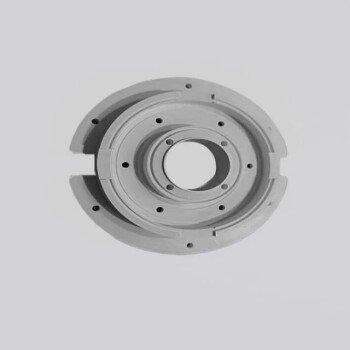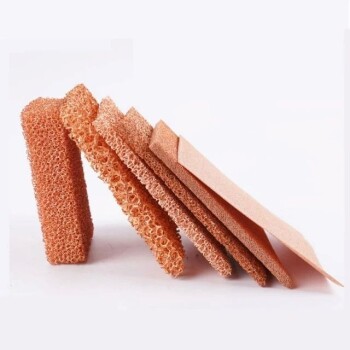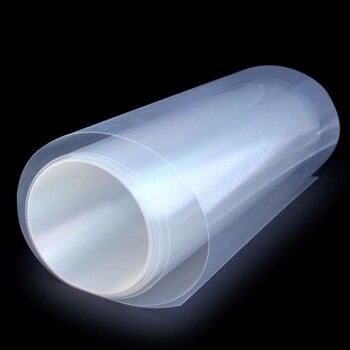In short, muffle furnaces use specialized high-temperature insulators known as refractory materials. The most common types are lightweight refractory ceramic fiber (RCF), often sold as blankets or boards, and insulating fire bricks (IFB). These materials are chosen for their ability to withstand extreme heat while preventing it from escaping.
The selection of an insulator for a muffle furnace is not about a single "best" material, but about choosing the right refractory based on required temperature, heating speed, and mechanical durability. The core challenge is to contain extreme heat efficiently and safely.
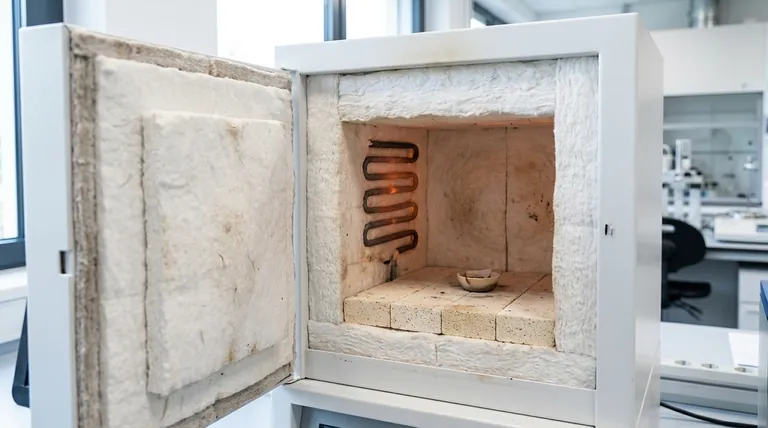
What Makes a Good Muffle Furnace Insulator?
To understand why specific materials are used, you must first understand the demanding environment inside a furnace. An effective insulator must possess a unique combination of thermal and physical properties.
High-Temperature Stability (Refractoriness)
The primary requirement is the ability to withstand the furnace's maximum operating temperature without melting, deforming, or breaking down. This property is known as refractoriness.
Materials used must have a service temperature rating significantly higher than the furnace's intended use. For instance, a furnace designed for 1200°C might use insulation rated for 1400°C or higher.
Low Thermal Conductivity
A good insulator must be a poor conductor of heat. This property, low thermal conductivity, is what keeps the heat inside the furnace chamber and the outer shell cool to the touch.
This is achieved by using materials with a porous internal structure. The trapped air or vacuum within these pores are very poor heat conductors, effectively slowing the transfer of thermal energy.
Low Thermal Mass
Thermal mass is the ability of a material to store heat. For a furnace that needs to heat up and cool down quickly, an insulator with low thermal mass is critical.
Materials like ceramic fiber have very low thermal mass, allowing for rapid temperature changes and improving energy efficiency, as less energy is wasted heating the insulation itself.
Chemical Inertness
The insulating material should not react with the atmosphere inside the furnace or with any fumes or substances released from the samples being heated. Chemical inertness ensures the longevity of the insulation and prevents contamination of the workload.
Common Insulating Materials in Detail
While many refractories exist, two dominate the construction of modern laboratory and industrial muffle furnaces.
Refractory Ceramic Fiber (RCF)
Also known as alumina-silica fiber, RCF is a lightweight, highly efficient insulator. It's often supplied as a flexible blanket, rigid board, or moldable vacuum-formed shape.
Its extremely low thermal conductivity and low thermal mass make it the ideal choice for furnaces that require rapid heating and cooling cycles. Most modern, energy-efficient lab furnaces are built primarily with RCF.
Insulating Fire Bricks (IFB)
IFBs are lightweight, porous bricks made from refractory clays. They are graded by their maximum service temperature (e.g., Grade 23 for 2300°F / 1260°C).
While they have a higher thermal mass than ceramic fiber, they offer superior mechanical strength and rigidity. They are often used to form the structural part of the chamber, particularly the floor, where physical support is needed.
Understanding the Trade-offs: Fiber vs. Brick
The choice between ceramic fiber and insulating fire bricks involves a clear set of trade-offs. Many furnaces use a combination of both to leverage their respective strengths.
Heating and Cooling Speed
Ceramic fiber's low thermal mass allows a furnace to reach its setpoint temperature much faster and cool down more quickly. Furnaces made entirely of IFB have slower thermal response times.
Durability and Mechanical Strength
Insulating fire bricks are far more rigid and resistant to physical damage and abrasion than ceramic fiber blankets. The hearth plate or floor of a furnace is often made of dense refractory brick or silicon carbide to withstand wear and tear from loading and unloading.
Health and Safety Considerations
Refractory ceramic fibers are a respiratory concern. When cut, handled, or disturbed, they can release fine, airborne fibers that are classified as a potential carcinogen. Proper personal protective equipment (PPE), including a respirator, is mandatory when working with or repairing RCF insulation. IFBs are generally safer to handle.
Making the Right Choice for Your Application
Your choice of insulation—or the furnace you purchase—depends entirely on your operational goals.
- If your primary focus is rapid heating cycles and energy efficiency: A furnace insulated predominantly with refractory ceramic fiber (RCF) is the superior choice.
- If your primary focus is mechanical durability and a robust chamber: A furnace constructed with a hard insulating fire brick (IFB) interior will provide a longer service life under heavy use.
- If you are working at extreme temperatures (above 1400°C): You will need to look for furnaces using specialized high-purity alumina fibers or dense zirconia refractories.
Ultimately, understanding the properties of these refractory materials empowers you to select a furnace that is not just functional, but perfectly suited to your specific task.
Summary Table:
| Insulator Type | Key Properties | Best For Application |
|---|---|---|
| Refractory Ceramic Fiber (RCF) | Low thermal mass, rapid heating/cooling, high energy efficiency | Fast cycle times, energy savings, general lab use |
| Insulating Fire Bricks (IFB) | High mechanical strength, durable, rigid structure | Heavy workloads, abrasive environments, robust chamber needs |
| Specialized High-Temp (e.g., Alumina, Zirconia) | Extreme temperature stability (>1400°C) | High-temperature applications, specialized research |
Optimize your laboratory's heating processes with the right muffle furnace insulation. At KINTEK, we specialize in providing high-quality lab equipment and consumables tailored to your specific needs. Whether you require the rapid heating of ceramic fiber or the durability of fire bricks, our experts can help you select the perfect furnace for your application. Contact us today to discuss how our solutions can enhance your lab's efficiency, safety, and performance.
Visual Guide
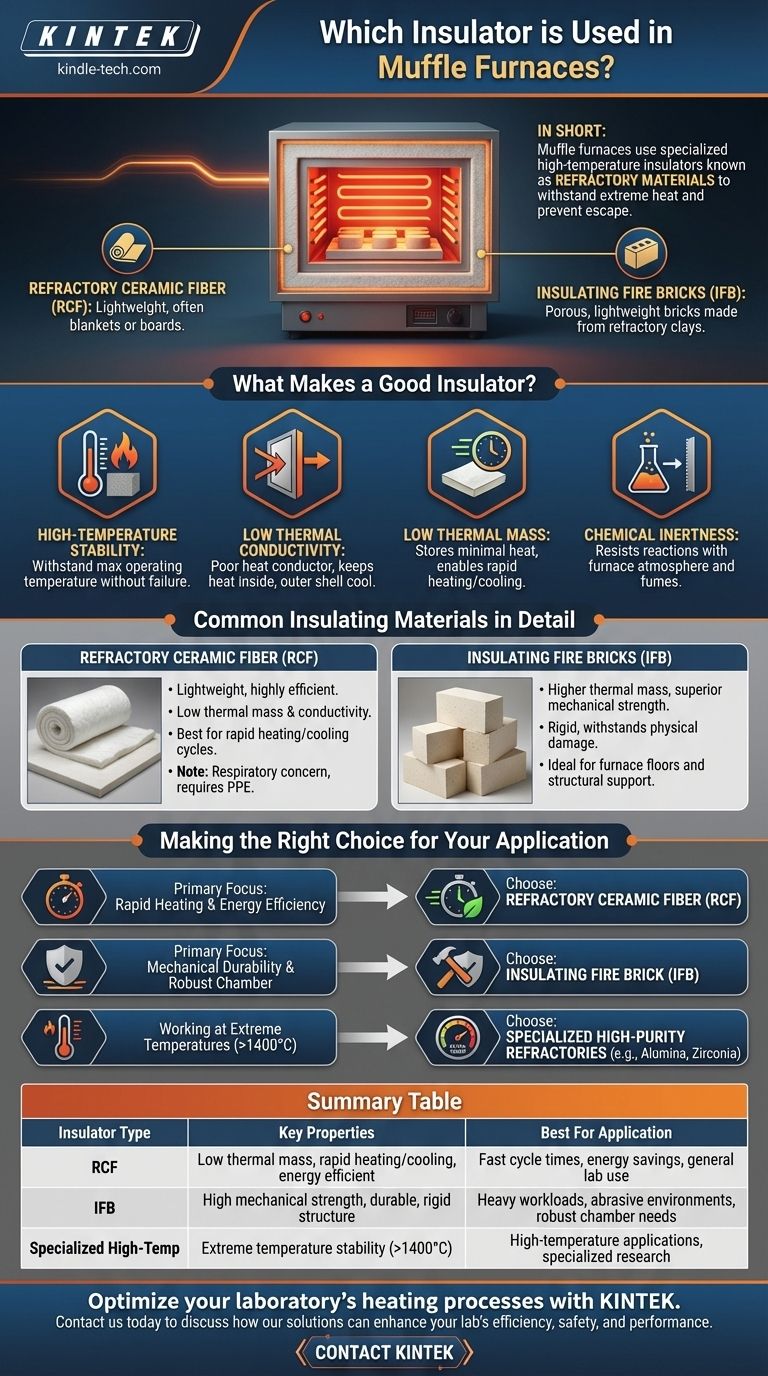
Related Products
- 1400℃ Muffle Oven Furnace for Laboratory
- High Temperature Muffle Oven Furnace for Laboratory Debinding and Pre Sintering
- Zirconia Ceramic Gasket Insulating Engineering Advanced Fine Ceramics
- Custom PTFE Teflon Parts Manufacturer for Non-Standard Insulator Customization
- Molybdenum Vacuum Heat Treat Furnace
People Also Ask
- How accurate is the muffle furnace? Achieve ±1°C Control and ±2°C Uniformity
- What are the different types of laboratory furnaces? Find the Perfect Fit for Your Application
- What is the difference between a muffle furnace and a normal furnace? Ensuring Sample Purity with Indirect Heating
- What are the disadvantages of a muffle furnace? Understanding the Trade-offs for Your Lab
- What is done by ashing in muffle furnace? A Guide to Precise Inorganic Content Analysis









